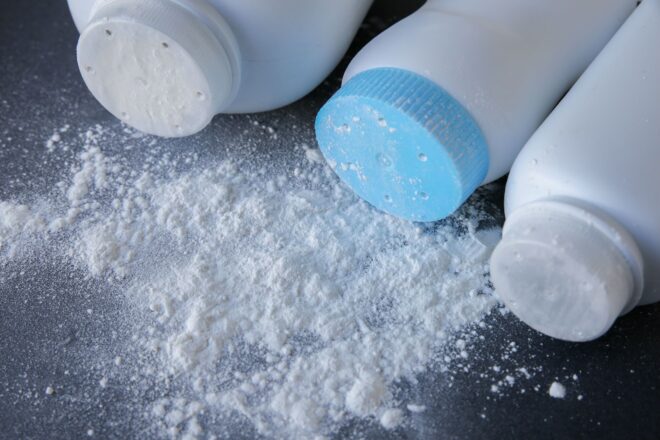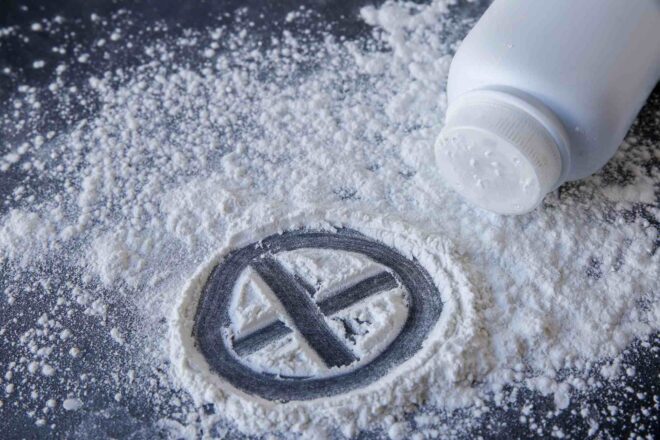Talcum powder, a seemingly harmless household product, has been a staple in bathrooms and nurseries for generations. Its ability to keep skin dry and reduce friction has made it a popular choice for various personal care routines. However, recent revelations have shed light on the dark secrets lurking within the talcum powder industry and the alarming toll it has taken on public health.
In this article, we will discuss the hidden dangers of talcum powder, the legal battles it has ignited, the lack of regulatory oversight, and the quest for safer alternatives.
Talcum Powder and Ovarian Cancer

Talcum powder has been an everyday item for a long time. It is widely used for its ability to absorb moisture and reduce friction. From baby powders to cosmetics and personal care products, talcum powder has found its way into the lives of millions. However, beneath its innocent appearance lies a dark secret that has shaken the trust of consumers.
One of the most alarming revelations in recent years is the potential link between talcum powder and ovarian cancer. Several scientific studies have found evidence suggesting that the use of talcum powder in the genital area may increase the risk of developing ovarian cancer.
When talc particles are used for an extended length of time, they can travel through the reproductive system and create inflammation, which can lead to the production of malignant cells. As stated in a post by Mesothelioma Guide, this relationship between talc and ovarian cancer is concerning. Therefore, women who use, or have used, talc-based products on a daily basis should be aware of the possible hazards.
Legal Battles and Massive Lawsuits
The connection between talcum powder and ovarian cancer has sparked a wave of lawsuits against manufacturers. Johnson & Johnson, one of the leading talcum powder producers, recently proposed a massive $8.9 billion settlement for the cases, with the intention to clear all current and future cases.
TorHoerman Law has highlighted that while the proposal is awaiting approval from a bankruptcy court, new lawsuits have followed. The fact that new lawsuits are still being filed sheds light on the industry’s negligence and lack of transparency regarding the potential risks associated with talcum powder use.
It is best to seek assistance from personal injury law firms that can provide an expert talcum powder lawyer for high-profile lawsuits like these. Defendants like Johnson & Johnson often employ skilled attorneys experienced in handling such cases. Therefore, individuals involved in these lawsuits require expert help and guidance to navigate the legal complexities successfully.
Contamination With Asbestos

Another concerning aspect of the talcum powder industry is the contamination of products with asbestos, a known carcinogen. Asbestos is a naturally occurring mineral often found in close proximity to talc deposits.
Drugwatch.org reports that even though efforts have been made to remove asbestos from talcum powder, instances of contamination continue to be reported. Ingesting or inhaling asbestos fibers can have grave consequences on health, including the development of lung cancer and mesothelioma.
Babies are especially vulnerable to the potential health risks associated with talcum powder contaminated with asbestos. This is because infants have a higher respiratory rate and may be more prone to inhaling fine particles containing asbestos.
Lack of Regulatory Oversight
One of the reasons talcum powder has been able to remain on store shelves despite these controversies is the lack of stringent regulations governing its safety. In the United States, for example, the Food and Drug Administration (FDA) classifies talcum powder as a cosmetic, which means it does not require pre-market approval or testing for safety.
According to the FDA, under the Federal Food, Drug, and Cosmetic Act, cosmetic goods and substances, with the only exception of color additives, do not require FDA review or approval before being placed on the market. This regulatory gap allows manufacturers to self-regulate and downplay the potential risks associated with their products.
Safer Alternatives and Consumer Empowerment

In light of the concerns surrounding talcum powder, consumers are seeking safer alternatives. Many companies have responded to the demand by introducing talc-free powders made from ingredients like cornstarch or arrowroot. These alternatives provide similar benefits without potential health risks. Additionally, consumer advocacy groups are pushing for stronger regulations and increased transparency in the industry to ensure public safety.
Final Word
The talcum powder industry’s cover-ups and the toll they take on public health have raised serious concerns. The probable relationship between talcum powder and ovarian cancer, combined with product contamination with asbestos, has generated serious concerns regarding the safety of this often-used household item.
The persistent legal fights and lack of regulatory control have brought the industry’s irresponsibility and lack of transparency to the forefront. However, in the middle of these discoveries, consumers have gained the ability to select safer alternatives and seek stricter controls.
The search for talc-free alternatives, as well as the campaign for more industry openness, are important steps in ensuring safety for everyone and holding manufacturers accountable for the possible health concerns connected with their products.



